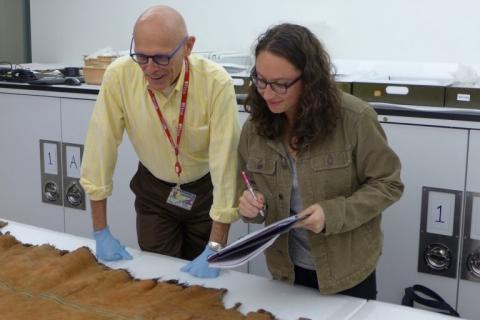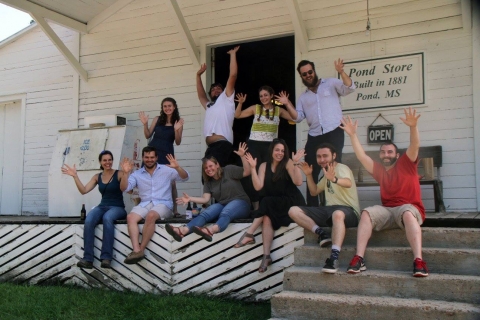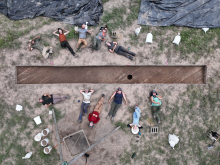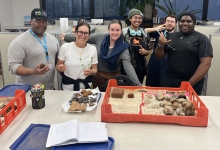Archaeology in North America @Penn


Natchez Bluff Archaeological Project
The Mississippi River played a defining role in the lives of pre-colonial communities in the eastern United States. Due to the natural abundance of the river and its associated floodplains, the Lower Valley region was always advanced in terms of monumental constructions and is home to thousands of earthen mounds and associated settlements. The mounds demonstrate high levels of variation in terms of form, size, and elaboration and have given rise to many unresolved debates as to their functions and meanings. The Natchez Bluffs Archaeological Project focuses on a series of mound sites that served as important ritual centers for over 1000 years, as well as the domestic sites associated with them. The primary research goal is to understand the complex relationships that existed between monument construction and identity, as well as foodways and politics, through archaeological excavation and analysis of the recovered materials.
Beginning in 2015 under the direction of Dr. Megan Kassabaum, the project has thus far focused on four mound sites—Smith Creek, Feltus, Lessley, and Pumpkin Lake—and associated settlements that span the transitions from egalitarian to hierarchical social organization and from hunting and gathering to agriculture. The project involves a large number of Penn graduate and undergraduate students both in the field and in the North American Archaeology Lab where the excavated materials are housed. Exhibitions at both the Penn Museum and the Wilkinson County Museum in Woodville, MS have displayed artifacts recovered by the project and interpreted this important history for public audience. Stay updated on the project on Facebook and Instagram.

Heritage West
Heritage West is a collaboration between community organizations (like HopePHL, the Black Bottom Tribe Association, and the Community Education Center), the Penn Museum, and Penn Anthropologists. As such, it is a community-informed archaeological project created with the goal of using archaeology to highlight the stories of individuals who lived in the Black Bottom neighborhood of West Philadelphia from the 19th century to the present. Through community conversations, the documentation of family stories and photos, and a local archaeological excavation, the Heritage West Project works with local community members to explore the vibrant histories of this important neighborhood.You can stay upated on Heritage West on Facebook and Instagram.



Archaeology in the Middle East @Penn
Naxçivan Archaeological Project (NAP)
Naxçivan, Azerbaijan
Project Directors: Dr. Lauren Ristvet, Dr. Hilary Gopnik, Dr. Vəli Baxşəliyev, and Dr. Emily Hammer
Visit the project webpage here.
Current Graduate Students
Archaeology in Latin America @Penn
Tihosuco Heritage Preservation and Community Development Project
Quintana Roo, Mexico
Project Director: Dr. Richard Leventhal
The Tihosuco Heritage Preservation and Community Development Project is an ongoing collaboration between the PennCHC, the Museum of the Caste War, the Tihosuco Ejido, and the Mayor’s office of Tihosuco. Together with the PennCHC, these partners are committed to exploring diverse aspects of local cultural patrimony and evolving Maya identity.
Tihosuco, a small Maya town located on Quintana Roo’s northern frontier with the state of Yucatán, has a unique history as the place where the Caste War started in 1847. A rebellion and war of resistance that lasted many decades, the Caste War’s imprint defines both the region and the town. The Caste War of Yucatán (also known as the Maya Social War) is generally acknowledged as the longest and most successful indigenous rebellion in Latin American history. For the past 80 years, the people of Tihosuco have been preserving the remnants of this rebellion on their ejido lands. Abandoned towns, haciendas, ranchos, roads and walls are all found throughout the ejido lands surrounding the town.
Tihosuco’s remarkable early colonial history, its abandonment during the 60-year Caste War and eventual re-settlement in the 1930s creates a natural division in research focus: before and after abandonment. Personnel from the Tihosuco partners, the University of Pennsylvania, and Mexican scholars respond to community-defined priorities focused on the ties that bind place and people, the past to the present and the present to the future.
The project aims to
- Helps bring small-scale economic growth to the town and community based on its rich cultural heritage
- Through research and community engagement, creates an interpretive framework for the rebellion story to be understood and presented by Maya people of Tihosuco
- Preserves the physical evidence of the colonial and Caste War eras
Current Graduate Students
Archaeology in South Asia @Penn
UNDER CONSTRUCTION
Primary Supervising Faculty from Anthropology
Dr. Megan C. Kassabaum: mkass@sas.upenn.edu
Dr. Richard Leventhal: rml@sas.upenn.edu

 Department of Anthropology
Department of Anthropology